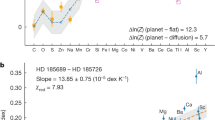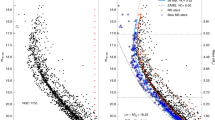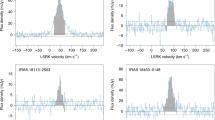Abstract
The mass and chemical composition of a star are the primary determinants of its basic physical properties—radius, temperature and luminosity—and how those properties evolve with time1. Accordingly, two stars born at the same time, from the same natal material and with the same mass, are ‘identical twins,’ and as such might be expected to possess identical physical attributes. We have discovered in the Orion nebula a pair of stellar twins in a newborn binary star system2. Each star in the binary has a mass of 0.41 ± 0.01 solar masses, identical to within 2 per cent. Here we report that these twin stars have surface temperatures differing by ∼300 K (∼10 per cent) and luminosities differing by ∼50 per cent, both at high confidence level. Preliminary results indicate that the stars’ radii also differ, by 5–10 per cent. These surprising dissimilarities suggest that one of the twins may have been delayed by several hundred thousand years in its formation relative to its sibling. Such a delay could only have been detected in a very young, definitively equal-mass binary system3. Our findings reveal cosmic limits on the age synchronization of young binary stars, often used as tests for the age calibrations of star-formation models4.
This is a preview of subscription content, access via your institution
Access options
Subscribe to this journal
Receive 51 print issues and online access
$199.00 per year
only $3.90 per issue
Buy this article
- Purchase on Springer Link
- Instant access to full article PDF
Prices may be subject to local taxes which are calculated during checkout



Similar content being viewed by others
References
Andersen, J. Accurate masses and radii of normal stars. Astron. Astrophys. Rev. 3, 91–126 (1991)
Cargile, P. A., Stassun, K. G. & Mathieu, R. D. Discovery of Par 1802 as a low-mass pre-main-sequence eclipsing binary in the Orion star-forming region. Astrophys. J. 674, 329–335 (2008)
D’Antona, F. & Mazzitelli, I. Evolution of low mass stars. Mem. Soc. Astron. It. 68, 807–822 (1997)
Luhman, K. L. Young low-mass stars and brown dwarfs in IC 348. Astrophys. J. 525, 466–481 (1999)
Stassun, K. G., Mathieu, R. D., Vaz, L. P. R., Stroud, N. & Vrba, F. J. Dynamical mass constraints on low-mass pre-main-sequence stellar evolutionary tracks: an eclipsing binary in Orion with a 1.0 M primary and a 0.7 M secondary. Astrophys. J. 151 (Suppl.). 357–385 (2004)
Covino, E., Frasca, A., Alcala, J. M., Paladino, R. & Sterzik, M. F. Improved fundamental parameters for the low-mass pre-main sequence eclipsing system RX J0529.4 + 0041. Astron. Astrophys. 427, 637–649 (2004)
Stassun, K. G., Mathieu, R. D. & Valenti, J. Discovery of two young brown dwarfs in an eclipsing binary system. Nature 440, 311–314 (2006)
Stassun, K. G., Mathieu, R. D. & Valenti, J. A surprising reversal of temperatures in the brown dwarf eclipsing binary 2MASS J05352184–0546085. Astrophys. J. 664, 1154–1166 (2007)
Irwin, J. et al. The Monitor project: JW 380: a 0.26-, 0.15-M, pre-main-sequence eclipsing binary in the Orion nebula cluster. Mon. Not. R. Astron. Soc. 380, 541–550 (2007)
Wilson, R. E. & Devinney, E. J. Realization of accurate close-binary light curves: application to MR Cygni. Astrophys. J. 166, 605–620 (1971)
Prsa, A. & Zwitter, T. A computational guide to physics of eclipsing binaries. I. Demonstrations and perspectives. Astrophys. J. 628, 426–438 (2005)
Allard, F., Hauschildt, P. H. & Schweitzer, A. Spherically symmetric model atmospheres for low-mass pre-main-sequence stars with effective temperatures between 2000 and 6800 K. Astrophys. J. 539, 366–371 (2000)
Hillenbrand, L. A. On the stellar population and star-forming history of the Orion Nebula Cluster. Astron. J. 113, 1733–1768 (1997)
Bagnuolo, W. G. & Gies, D. R. Tomographic separation of composite spectra—The components of the O-star spectroscopic binary AO Cassiopeiae. Astrophys. J. 376, 266–271 (1991)
Zucker, S. & Mazeh, T. Study of spectroscopic binaries with TODCOR. 1: A new two-dimensional correlation algorithm to derive the radial velocities of the two components. Astrophys. J. 420, 806–810 (1994)
Slesnick, C. L., Hillenbrand, L. A. & Carpenter, J. M. The spectroscopically determined substellar mass function of the Orion Nebula cluster. Astrophys. J. 610, 1045–1063 (2004)
Genzel, R. & Stutzki, J. The Orion molecular cloud and star-forming region. Annu. Rev. Astron. Astrophys. 27, 41–85 (1989)
Torres, G., Lacy, C. H., Marschall, L. A., Sheets, H. A. & Mader, J. A. The eclipsing binary V1061 Cygni: Confronting stellar evolution models for active and inactive solar-type stars. Astrophys. J. 640, 1018–1038 (2006)
Chabrier, G., Gallardo, J. & Baraffe, I. Evolution of low-mass star and brown dwarf eclipsing binaries. Astron. Astrophys. 472, L17–L20 (2007)
Ribas, I. et al. Fundamental properties of low-mass stars. Mem. Soc. Astron. It. 79, Proc. Workshop ‘XXI Century Challenges for Stellar Evolution’ (eds Cassisi, S. & Salaris, M.) (in the press)
Stellingwerf, R. F. Period determination using phase dispersion minimization. Astrophys. J. 224, 953–960 (1978)
Robberto, M. et al. An overview of the HST Treasury Program on the Orion Nebula. Bull. Am. Astron. Soc. 37, 1404 (2005)
Zacharias, N. et al. The Naval Observatory Merged Astrometric Dataset (NOMAD). Bull. Am. Astron. Soc. 36, 1418 (2004)
Skrutskie, M. F. et al. The Two Micron All Sky Survey (2MASS). Astron. J. 131, 1163–1183 (2006)
Cox, A. N. (ed.) Allen’s Astrophysical Quantities 4th edn (Springer, New York, 2001)
Campins, H., Rieke, G. H. & Lebofsky, M. J. Absolute calibration of photometry at 1 through 5 microns. Astrophys. J. 90, 896–899 (1985)
Cousins, A. J. VRI standards in the E regions. Mem. R. Astron. Soc. 81, 25 (1976)
Bessell, M. S. UBVRI photometry. II—The Cousins VRI system, its temperature and absolute flux calibration, and relevance for two-dimensional photometry. Publ. Astron. Soc. Pacif. 91, 589–607 (1979)
Cohen, M., Wheaton, W. A. & Megeath, S. T. Spectral irradiance calibration in the infrared. XIV. The absolute calibration of 2MASS. Astron. J. 126, 1090–1096 (2003)
Fazio, G. An IRAC Survey of the L1630 and L1641 (Orion) Molecular Clouds. Spitzer Space Telescope - Guaranteed Time Observer Proposal #43 〈http://ssc.spitzer.caltech.edu/geninfo/gto/abs/43.txt〉.
Acknowledgements
We thank A. Prsa for software used in our analyses. This work is supported by grants to K.G.S. and R.D.M. from the National Science Foundation, and a Cottrell Scholar award to K.G.S. from the Research Corporation. K.G.S. acknowledges the hospitality of the Space Telescope Science Institute’s Caroline Herschel Distinguished Visitor programme.
Author information
Authors and Affiliations
Corresponding author
Supplementary information
Supplementary information
The file contains Supplementary Discussion, Supplementary Figure 1 with Legend and Supplementary Table 1. A detailed discussion of the methods is presented by which the flux ratio of the components of Par 1802 is determined from analysis of spectra obtained at multiple orbital phases. The Supplementary Figure 1 illustrates this spectroscopic analysis and the measurement of the flux ratio. The Supplementary Table 1 lists the flux measurements of Par 1802 over the wavelength range 0.36 to 8.0 micrometres, which are used in the paper to determine the distance and interstellar extinction to the system (Figure 2). (PDF 580 kb)
Rights and permissions
About this article
Cite this article
Stassun, K., Mathieu, R., Cargile, P. et al. Surprising dissimilarities in a newly formed pair of ‘identical twin’ stars. Nature 453, 1079–1082 (2008). https://doi.org/10.1038/nature07069
Received:
Accepted:
Issue Date:
DOI: https://doi.org/10.1038/nature07069
Comments
By submitting a comment you agree to abide by our Terms and Community Guidelines. If you find something abusive or that does not comply with our terms or guidelines please flag it as inappropriate.



